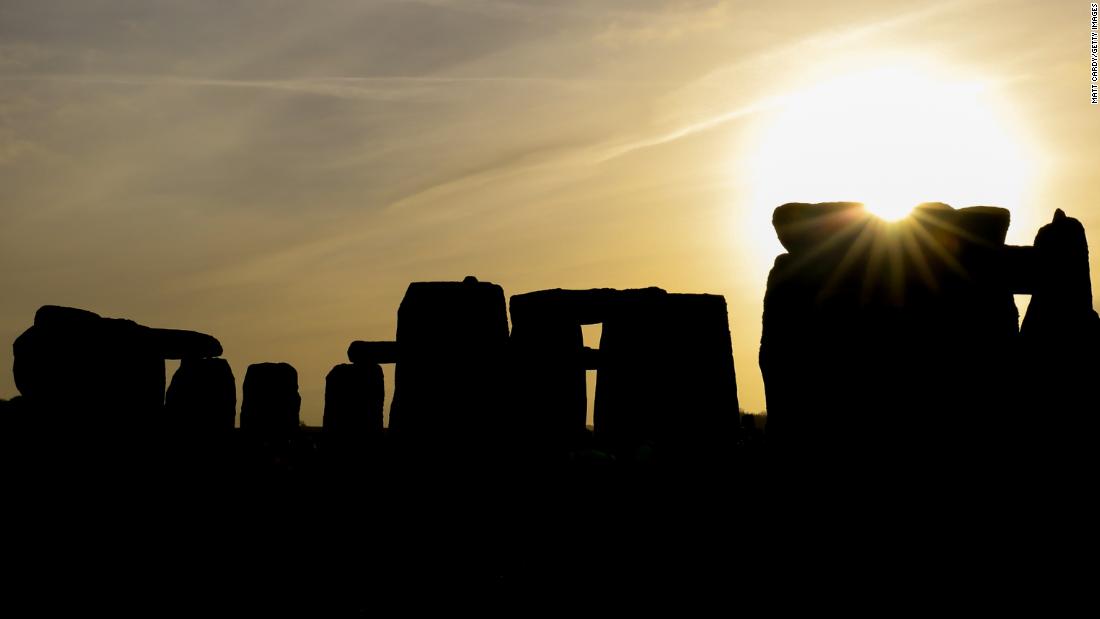(CNN) — For the past six months, the days have grown shorter and the nights have grown longer in the Northern Hemisphere. But that’s about to reverse itself.
Winter solstice 2022, the shortest day of year and the official first day of winter, is on Wednesday, December 21 (well, for a decent chunk of the world anyway). How this all works has fascinated people for thousands of years.
First we’ll look at the science and precise timing behind the solstice. Then we’ll explore some ancient traditions and celebrations around the world.
The science and timing behind a winter solstice
The winter solstice marks the shortest day of the year and the longest night in the Northern Hemisphere, when the sun appears at its most southerly position, directly overhead at the Tropic of Capricorn.
The situation is the reverse in the Southern Hemisphere, where only about 10% of the world’s population lives. There, the December solstice marks the longest day of the year — and the beginning of summer — in places such as Argentina, Madagascar, New Zealand and South Africa.

These three images from NOAA’s GOES East (GOES-16) satellite show us what Earth looks like from space near the winter solstice. The images were captured about 24 hours before the 2018 winter solstice. You can see how the Northern Hemisphere is cloaked in more darkness.
NOAA
When exactly does it occur?
The solstice usually — but not always — takes place on December 21. The date that the solstice occurs can shift because the solar year (the time it takes for the sun to reappear in the same spot as seen from Earth) doesn’t exactly match up to our calendar year.

The sun sets at Ocean Beach in San Francisco on winter solstice 2020.
Jane Tyska/Digital First Media/East Bay Times/Getty Images
Below are some examples of when 21:48 UTC will be for various local times in places around the world. Because of time zone differences, the vast bulk of Asia will mark the winter solstice on Thursday, December 22.
• Tokyo: 6:48 a.m. Thursday
• Hanoi, Vietnam: 4:48 a.m. Thursday
• New Delhi: 3:18 a.m. Thursday
• Istanbul: 12:48 a.m. Thursday
• Jerusalem: 11:48 p.m. Wednesday
• Copenhagen, Denmark: 10:48 p.m. Wednesday
• Charlotte, North Carolina: 4:48 p.m. Wednesday
• Winnipeg, Manitoba: 3:48 p.m. Wednesday
• San Francisco: 1:48 p.m. Wednesday
• Honolulu: 11:48 a.m. Wednesday
What places see and feel the effects of the winter solstice the most?
Daylight decreases dramatically the closer you are to the North Pole on December 21.

The illuminated Pont Alexandre III spans the Seine, adding to the magic of Paris in winter.
Frédéric Soltan/Corbis News/Getty Images
What causes the winter solstice to even happen?
Because Earth is tilted on its rotational axis, we have changing seasons. As the planet moves around the sun, each hemisphere experiences winter when it’s tilted away from the sun and summer when it’s tilted toward the sun.
Hold on! Why is the Earth tilted?
Scientists are not entirely sure how this occurred, but they think that billions of years ago, as the solar system was taking shape, the Earth was subject to violent collisions that caused the axis to tilt.
What other seasonal transitions do we mark?
The equinoxes, both spring and fall, occur when the sun’s rays are directly over the equator. On those two days, everyone everywhere has a nearly equal length of day and night. The summer solstice is when the sun’s rays are farthest north over the Tropic of Cancer, giving us our longest day and the official start of summer in the Northern Hemisphere.
Winter solstice traditions and celebrations

A view of the Rockefeller Center Christmas Tree for 2022. Many Christmas traditions have their roots in pagan celebrations.
John Lamparski/Getty Images
It’s no surprise many cultures and religions celebrate a holiday — whether it be Christmas, Hanukkah, Kwanzaa or pagan festivals — that coincides with the return of longer days.
Ancient peoples whose survival depended on a precise knowledge of seasonal cycles marked this first day of winter with elaborate ceremonies and celebrations. Spiritually, these celebrations symbolize the opportunity for renewal.
“Christmas takes many of its customs and probably its date on the calendar from the pagan Roman festivals of Saturnalia and Kalends,” Maria Kennedy, assistant teaching professor in the Department of American Studies at Rutgers University, told CNN Travel in an email.
Saturnalia started on December 17 and Kalends started on January 1, said Kennedy, who specializes in Christmas studies.
Citing academic research, Kennedy said early founders of the Christian church condemned the practices of these holidays, but their popularity endured. Christian observance of Christmas eventually aligned around the same time in the calendar even though there’s no specific date set in the Gospels for the birth of Jesus.
Here’s more on some of those ancient customs:
Alban Arthan
Saturnalia
In Ancient Rome, Saturnalia lasted for seven days. It honored Saturn, the Roman god of agriculture.
Dongzhi
It’s not just ancient Europeans who marked the annual occasion. The Dongzhi Winter Solstice Festival has its roots in ancient Chinese culture. The name translates roughly as “extreme of winter.”
Celebrations
Many places around the world traditionally hold festivals that honor the winter solstice. A few of them include:
Montol Festival

A choir sings at Stonehenge to mark the winter solstice.
Ben Birchall /PA Images/Getty Images
Stonehenge
Lantern Festival
CNN’s Katia Hetter and Autumn Spanne contributed to this article.
Note:- (Not all news on the site expresses the point of view of the site, but we transmit this news automatically and translate it through programmatic technology on the site and not from a human editor. The content is auto-generated from a syndicated feed.))




Thank you for your sharing. I am worried that I lack creative ideas. It is your article that makes me full of hope. Thank you. But, I have a question, can you help me?